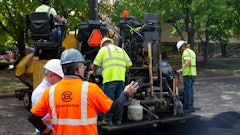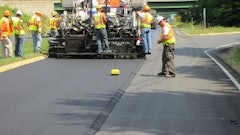
Why is our industry so reluctant to try new products and technologies?
The construction industry for too long has become accustomed to saying “no.”
With the historic passage of the Infrastructure Investment and Jobs Act (IIJA), we as an industry have an enormous opportunity to effect change, embrace new technologies and move the needle—forward.
This could be a challenge because our construction industry at large has long been inexplicably resistant to—and uncomfortable with—progress. But our roads—and our environment—demand new tools and practices that will reduce environmental impact and rising costs.
Let’s look at one example of how we could easily shift in a positive direction: the promulgation of cool pavements. By and large, this is a technology that’s a win-win for all parties.
This is a technology that is more durable than conventional pavement, deforms less quickly and lasts longer, owing to decreased absorption of solar energy over time. And it saves municipalities, businesses, and real estate developers significant money over the long haul.
Let’s consider a couple very positive impacts cool pavements have on the environment.
The first is the reduction in energy usage as local temperatures are cooled. Lower ambient temperatures allow air conditioners to cool buildings with less energy. In Los Angeles, where cool pavements are currently specified, temperature reductions attributed to increased pavement albedo (light reflection, rather than absorption) resulted in more than $90 million per year in savings. Reflective pavement also reduces energy at night as it demands slower street light usage.
Two years ago, the City of Phoenix Street Transportation Department and Office of Sustainability announced the results of the first year of its Cool Pavement Pilot Program, conducted in partnership with Arizona State University (ASU). Year one of the study conducted by by scientists at ASU’s Global Institute of Sustainability and Innovation, Healthy Urban Environments, and the Urban Climate Research Center revealed that reflective pavement surface temperatures are considerably lower than traditional roadway pavement.
“This is exactly what we were hoping for,” Phoenix Mayor Kate Gallego said. “The results are promising. While there’s more work to be done, it’s exciting to see a technology that has the potential to meet the demands of a growing desert city in a world where temperatures are constantly climbing.”
Cool pavement coating reflects a higher portion of the sunlight that hits it, hence absorbing less heat. Because of this higher reflection, the coating has the potential to offset rising nighttime temperatures in the region.
Phoenix’s success has inspired other pilot programs, including one currently underway in Davis, California. As part of the Climate Action and Adaptation Plan (CAAP), the City of Davis is taking actions to assess greenhouse gas (GHG) reduction progress made since the 2010 CAAP adoption. One of the City’s goals is to develop an ordinance to require the use of cool surfaces, reflective materials, and coatings to reduce the heat island effect.
Another cool-pavement advantage is an improvement in air quality. A reduction in energy usage would lower greenhouse emissions and air pollution (dependent on electric power fuel mix).[2] Lower temperatures would also slow chemical reactions that create smog.[1] In 2007, Surabi Menon and Hashem Akbari estimated that an increase of global pavement albedo of 35 to 39 percent could reduce carbon dioxide emissions worth about $400 billion.
So what is cool pavement?
Cool pavement is a road surface that uses additives to reflect solar radiation unlike conventional dark pavement. Conventional dark pavements contribute to urban heat islands as they absorb 80–95% of sunlight and warm the local air.[1] Cool pavements are made with different materials to increase albedo, thereby reflecting shortwave radiation out of the atmosphere, thereby reducing heat transfer to the surface. The EPA reports that “if pavement reflectance throughout a city were increased from 10 to 35 percent, the air temperature could potentially be reduced by 1°F (0.6°C)."[2] Existing dark pavement can be altered to increase albedo through whitetopping or by adding reflective coats and seals. New pavement can be constructed to increase albedo by using modified mixes, permeable pavements, and vegetated pavements.[3]
This idea isn’t actually new.
In the 1990s, scientists at Lawrence Berkeley National Laboratory calculated that if all pavements and roofs in downtown Los Angeles increased albedo by 25 and 35 percent, respectively, air temperatures would drop by nearly 3 degrees. If that happened throughout the city, and was combined with other efforts, the cooling effects could be even greater. In the years since, more studies have emerged, and they all agree: If done right, cool pavements can help cities move the needle on ending heat islands.
The Phoenix pilot project uses a water-based asphalt treatment that is applied on top of the existing asphalt pavement. It's made with asphalt, water, an emulsifying agent (soap), mineral fillers, polymers and recycled materials. It contains no harmful chemicals and is compatible with traditional asphalt.
Other pilot projects are currently underway in San Antonio and Tucson. Cool pavement is not a panacea, and it's not perfect. But it’s a technology that’s here-and-now. It can be created with existing paving technologies (such as asphalt and concrete) as well as newer approaches such as the use of coatings or grass paving.
If it’s widely commercialized and adopted, cool pavement technology will also become even less expensive and its impact more profound. It’s a progressive answer to the paving industry’s significant contribution to climate change.
Why aren’t we pushing for it? Let’s move the needle on this easy, available solution that will bring about positive improvement for our industry. And let’s open our minds to new ideas.
















![Img 1791[100]](https://img.forconstructionpros.com/files/base/acbm/fcp/image/2022/09/IMG_1791_100_.632c76e4ca400.png?auto=format%2Ccompress&fit=crop&h=135&q=70&w=240)












